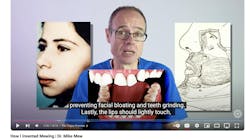Director's Message: What do the ADA landscape report and seltzer have in common?
The American Dental Association (ADA) has just released a study of the dental care sector in a report titled, "A Profession in Transition: Key Forces Reshaping the Dental Landscape." The report summarizes main findings of an environmental scan carried out by the ADA as part of the ADA’s 2015-2020 strategic plan development process.
My first glance at the ADA article left me feeling a little like the seltzer water on my last flight, tasting like it had been left out too long or is old, thus losing its carbon-dioxide infused goodness that we like to call fizz. The story is flat.
So on page 19 of the “landscape” paper, I clicked on the description (the full report is available on www.ada.org/escan).
To assist the American Dental Association in its strategic planning, Diringer and Associates was retained in March 2013 to manage the environmental scan of emerging trends that affect the future of dentistry.
Now, these reports have a more academic presentation. The dissemination of information and findings are referenced and seem to be less speculation and bias when considering the basic issues and trends facing our professions. They referred to an extensive literature review (seems to have followed National Library of Medicine citation style) and key informant interviews. The findings are organized into five themes:
- People
- Providers
- Payments
- Policies
- Practice Implications.
Below are the archetype topics as reported by the Critical Trends Affecting the Future of Dentistry Executive Summary.
People
- The population is getting older and more diverse, leading to different disease patterns, care‐seeking behavior and ability to pay.
- Consumers are becoming more astute purchasers of health care and seeking value for their spending.
Providers
- An increasing number of dentists are being trained, but mounting debt load and changing demographics are altering the practice choices for new dentists.
- Pressures are growing for an expanded dental team to provide preventive and restorative services.
- Care is being integrated within “patient centered medical homes” in medicine, but there has been slow taking up of dental care services.
Payments
- Payment for dental services is shifting from commercial dental insurance to public coverage and personal out of pocket payments.
- Commercial dental plans are increasingly using more selective networks, demanding increased accountability through data and performance measures, and pressuring providers to reduce costs.
Policies
- The Affordable Care Act pediatric dental benefit will provide millions of additional children with dental coverage through the small group and individual markets and optional Medicaid expansions.
- Public programs, with a growing number of participants, will require increased accountability from dental providers.
Practical Implications
- With the increased demand for value in dental care spending, practices will need to become more efficient.
- The trend towards larger, multi‐site practices will continue to be driven by dental plan pressures for smaller provider networks, practice patterns of new dentists and increased competition for patients.
- Health care reform and Medicaid expansions with an increasing emphasis on outcomes and cost‐effectiveness will encourage alternative models of dental care.
From this reader’s perspective, “Critical Trends Affecting the Future of Dentistry” has more sparkle and I suggest drinking that up.
Kristine A. Hodsdon RDH, MSEC
RDH eVillage, Director
Kristine’s Disclosures: Kristine is a dental consultant and trainer with Pride Institute, www.prideinstitute.com and owner of Dental Influencers, LLC www.dentalinfluencers.com.
She can be reached at [email protected].





